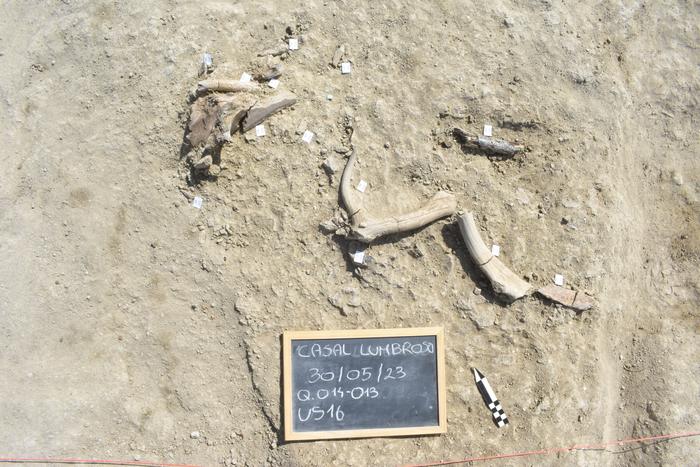Ancient Humans’ Ingenious Elephant Butchery at Casal Lumbroso: A Glimpse into Middle Pleistocene Survival Strategies
In a remarkable archaeological breakthrough, researchers at Sapienza University of Rome have shed new light on the subsistence strategies of ancient human populations during the Middle Pleistocene, approximately 400,000 years ago. Their study, recently published in the prestigious open-access journal PLOS One, meticulously analyzes the extraordinary remains of a straight-tusked elephant (Palaeoloxodon) uncovered at the Casal Lumbroso site, located on the outskirts of Rome, central Italy. This discovery offers compelling evidence of systematic elephant butchery by early humans during a warm climatic phase of the Middle Pleistocene, unveiling not only dietary practices but also technological adaptations that highlight the complexity of early human behavior.
The Casal Lumbroso site presents an extraordinary archaeological record comprising over 300 fossilized skeletal elements from a single giant elephant, amidst a dense assemblage of more than 500 stone tools. Dating through comparative analysis of ash deposits situates these remains at about 404,000 years ago, correlating with the Marine Isotope Stage 11, a notably mild interglacial period marked by elevated temperatures and enhanced ecological productivity. This temporal context is crucial for understanding the environmental backdrop against which early hominins exploited megafaunal resources with remarkable efficiency.
Upon detailed examination, researchers identified a series of fresh fractures on multiple elephant bones, indicative of forceful impacts shortly after the animal’s death. These breaks were associated with impact marks consistent with the deliberate use of blunt tools to break open bones, presumably to access marrow and other nutrient-rich tissues. Intriguingly, despite the extensive butchering, traditional cut marks commonly attributed to flesh slicing were conspicuously absent, suggesting the use of smaller, perhaps flint-based, cutting implements ill-suited to leaving diagnostic incisions on the dense megafaunal bones.
This hypothesis aligns with the lithic assemblage from Casal Lumbroso, predominantly composed of small stone tools less than 30 millimeters in size. The prevalence of diminutive tools poses fascinating questions about raw material availability, as larger stones might have been scarce or less favored by the hominin groups inhabiting this region. Such constraints could have led to adaptive tool production strategies optimized for specific butchery tasks, such as incising soft tissues, skinning, and disarticulation, while larger tasks like bone fracturing relied on modified bones or stone hammers.
Indeed, further examination revealed that several elephant bones themselves were deliberately modified post-mortem, repurposed as robust tools. This dual use of elephant resources—both as sustenance and as raw material for tool manufacture—attests to a sophisticated understanding and exploitation of megafaunal remains. Early humans transformed these enormous creatures into multifunctional assets, reflecting a complex behavioral repertoire that extended beyond mere hunting or scavenging.
The findings from Casal Lumbroso resonate with evidence from other Middle Pleistocene sites across central Italy, which also show similar patterns of bone modification and integration of small stone tools in the processing of elephants. This recurring pattern hints at a consistent cultural or technological tradition among early European hominin groups during warm periods, underscoring the role of climatic and environmental factors in shaping human subsistence and technological innovation.
From an evolutionary perspective, the ability to exploit large herbivores like elephants for both food and raw material signifies an advanced stage of cognitive and cultural development. It implies strategic planning, knowledge transmission, and skillful manipulation of available technologies. Moreover, these activities would have required coordinated group efforts, given the sheer size and complexity involved in butchering such vast animals.
Beyond the mere economic dimension, this study invigorates our understanding of human–animal–environment interactions during a dynamic epoch in human prehistory. It encapsulates a scenario where early humans were active agents in their ecosystems, adapting to and capitalizing on fluctuating climatic conditions to enhance their survival prospects. The interdisciplinary methodologies employed—ranging from stratigraphic ash analysis, detailed taphonomic assessments to lithic technology studies—demonstrate a holistic approach to unraveling ancient lifeways.
Dr. Beniamino Mecozzi and colleagues emphasize that their work resurrects vanished ecological and cultural landscapes, illuminating the intricate web of relationships among hominins, megafauna, and their environments nearly half a million years ago. This glimpse into the past not only enriches the archaeological record but also challenges modern perceptions of early human capabilities, revealing a nuanced picture of adaptation, resilience, and ingenuity.
Importantly, this discovery underscores central Italy’s significance as a key region for paleoanthropological research. Its geological and climatic history has preserved unparalleled evidence that continues to refine our narrative of human evolution in Europe. The Casal Lumbroso findings contribute a vital chapter to this story, enhancing comprehension of early hominin subsistence strategies at a time when human cognitive and cultural capacities were rapidly evolving.
As research advances, such nuanced insights pave the way for deeper exploration of how early humans exploited megafaunal resources on a continent teeming with rich biodiversity and climatic variability. The Casal Lumbroso site stands as a testament to the enduring legacy of human innovation, offering a window into one of the earliest and most complex examples of megafaunal butchery and tool use in prehistory.
For those eager to delve into the full details of this groundbreaking study, the freely accessible article is available in PLOS One, reflecting an open-science commitment to sharing key discoveries with both the academic community and the broader public.
Subject of Research: People
Article Title: From meat to raw material: the Middle Pleistocene elephant butchery site of Casal Lumbroso (Rome, central Italy)
News Publication Date: 8-Oct-2025
Web References: http://plos.io/4gIj95A
References: Mecozzi B, Fiore I, Giaccio B, Giustini F, Mercurio S, Monaco L, et al. (2025) From meat to raw material: the Middle Pleistocene elephant butchery site of Casal Lumbroso (Rome, central Italy). PLoS One 20(10): e0328840. https://doi.org/10.1371/journal.pone.0328840
Image Credits: Beniamino Mecozzi, CC-BY 4.0 (https://creativecommons.org/licenses/by/4.0/)
Keywords: Middle Pleistocene, elephant butchery, Casal Lumbroso, Palaeoloxodon, stone tools, megafauna exploitation, human evolution, lithic technology, taphonomy, archaeological site, interglacial period, prehistoric subsistence strategies




